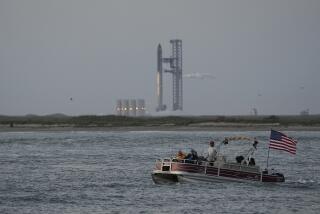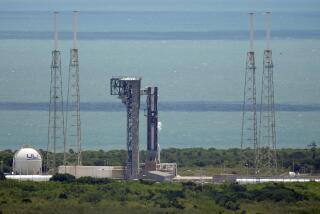Shuttle Explodes; All 7 Die : Teacher on Board as Challenger Blows Up on Liftoff : Reagan Postpones Future Flights Pending a Probe
KENNEDY SPACE CENTER, Fla. — The space shuttle Challenger exploded in a huge fireball less than two minutes after takeoff today, with all seven crew members--including New Hampshire teacher Sharon Christa McAuliffe--feared dead.
Airborne paramedics parachuted quickly into the calm waters off Cape Canaveral in a vain search for survivors. Though there was no immediate announcement on the fate of the crew, all were believed dead.
The disaster--the worst in the history of America’s manned space program--came shortly after the Challenger blasted off on a cold Florida morning on the 25th shuttle mission.
Without warning, there was an explosion, either in one of the solid rocket boosters or in the main fuel tank, and the flames engulfed Challenger.
The shuttle, rocketing upward at more than 1,900 miles an hour, appeared to incinerate instantly, disappearing into a ball of yellow flame, tinged in red.
Little Remained
Television pictures provided by the National Aeronautics and Space Administration and replayed time and again to a stunned national audience by the networks showed only the smoky tracks of debris--what little remained of the shuttle and its booster rockets--plummeting into the Atlantic Ocean.
Missing and presumed dead were shuttle commander Francis “Dick” Scobee, 46, co-pilot Michael Smith, 40, and astronauts Judith Resnick, 36, Ellison Onizuka, 39, Ronald E. McNair, 35, Gregory Jarvis, 41, and McAuliffe, 37.
Late in the morning, President Reagan told the media that there will be no more manned space missions until the cause of the disaster is established. “I’m sure there will be no more flights,” he said. “It’s a horrible thing all of us have witnessed.”
The President was described as stunned as he watched television replays of the disaster and he later postponed until next Tuesday the State of the Union message scheduled for delivery to Congress tonight.
Shock and Tears
Students at Concord High School in Concord, N.H., where McAuliffe taught, watched in horror on television monitors and reacted with a mixture of shock and tears as the shuttle disappeared in flame.
“I don’t believe it happened,” said one student, grimly. “Everyone’s watching her and she gets killed.”
Here at Kennedy Space Center, McAuliffe’s husband, two children and parents stood arm-in-arm, silently watching the fireball in the center’s VIP viewing platform.
A NASA official walked up to them and said, “The vehicle has exploded.”
The teacher’s mother, Grace Corrigan repeated the words as a question, “The vehicle has exploded?”
The family was quickly led away.
‘A Major Malfunction’
As the disaster unfolded before spectators here, Steven Nesbitt, the NASA announcer on the launch, said “flight controllers here are looking very carefully at the situation,” adding calmly that there appeared to be “a major malfunction.”
Then a few minutes later he confirmed the worst fears of those watching:
“We have a report from (a) flight dynamics officer that the vehicle has exploded. The flight director confirms that. We are looking at, uh, checking with the recovery forces to see what can be done at this point.”
As the contrails formed to the east of Cape Canaveral, a parachute appeared in the clear blue sky, giving spectators a small glimmer of hope. Challenger carried no parachutes or ejection devices for the crew.
Rescue personnel reacted as quickly as possible to the disaster. More than a dozen aircraft and small surface vessels, dodging falling debris, raced to the impact point 18 miles southeast of the launch pad.
As the minutes raced by, there was no word from NASA and what little hope there had been for news of survivors faded away.
No Immediate Explanation
NASA officials had no immediate explanation for the explosion, and it was not clear whether the explosion began in the two solid fuel booster rockets or the main fuel tank.
There was speculation that overnight temperatures of less than 28 degrees, which formed two-foot-long icicles on the launch pad, may have played some part in the disaster. The flight had been postponed two hours; one hour of the delay was attributed to possible danger from ice forming on the craft.
A NASA team inspected the boosters, main fuel tank and gantry area before the countdown was continued.
The explosion occurred one minute and 15 seconds into the flight at an altitude of 4.9 miles and the crew was just beginning to boost their engines up to full throttle, NASA officials said. There had been no indication of any problems from the crew on the radio.
“Challenger, go at throttle-up”--the order to go to full power--was given by Mission Control to the crew 52 seconds after liftoff.
Sense of Grief
Scobee’s final words came back, “Roger, go at throttle-up.” Telemetry from the craft simply stopped as the Challenger’s huge main fuel tank, carrying 526,000 gallons of volatile liquid hydrogen and oxygen, burst into flame. Seconds later, there was nothing but twisting contrails in the clear morning sky, and a sense of grief building up around the country.
The shuttle was not equipped with ejection equipment to separate the crew from the burning craft. The first four shuttle launches had ejection seats, but the need for more room in the craft and increased confidence in the shuttles’ reliability had convinced NASA officials to leave them off.
It was the 10th shuttle flight for the $1.1-billion Challenger and came 11 years and 1 day after the nation’s only previous fatal space disaster. On Jan. 27, 1967, there was a fire in an Apollo spacecraft as it sat on the launch pad here during a “dry run” in preparation for a later flight. Astronauts Virgil “Gus” Grissom, Edward H. White and Roger B. Chaffee died in the fire.
‘Stunned Silence’
In Washington, White House spokesman Larry Speakes said President Reagan watched in “stunned silence” as the networks replayed tapes of the explosion.
Nancy Reagan, a White House spokesman reported, “watched a live feed of the television picture, exclaiming, “Oh, my God, no!’ ”
Here at the launch center, many NASA workers seemed in a near state of shock. “I can’t believe it,” said one woman, near tears. Another young technician cried out, “The orbiter, I can’t see the orbiter, where is it?”
The flight of the Challenger had been postponed five times in recent days because of weather and minor technical problems.
The mission was designed to release and retrieve a satellite to study Halley’s comet and to launch a second satellite which was to become part of the shuttle program’s communications network.
Lessons to Earth
McAuliffe was scheduled to teach two 15-minute lessons on the fourth day of the mission. The Public Broadcasting Service was to carry the telecasts live with hundreds of schools planning to tune in. McAuliffe was the first private citizen selected in national competition to fly on the shuttle. She was selected from more than 11,000 teachers who applied to NASA.
Her husband, Steven J. McAuliffe, is a Concord lawyer. They have two children, Scott, 9, and Caroline, 6.
Scobee, the craft’s commander, was making his second space mission. A veteran Air Force pilot who flew combat missions in Vietnam, he was selected as an astronaut in 1979.
Smith, a U.S. Naval Academy graduate, was a Navy pilot and Vietnam veteran.
McNair was a civilian expert on laser research, while Onizuka was an aerospace engineer. Resnick, a specialist in the operation of the shuttle’s robot arm, was a civilian astronaut, as was Jarvis, a Hughes Aircraft Co. engineer on board to conduct tests on the effects of weightlessness on fluids.
More to Read
Sign up for Essential California
The most important California stories and recommendations in your inbox every morning.
You may occasionally receive promotional content from the Los Angeles Times.











